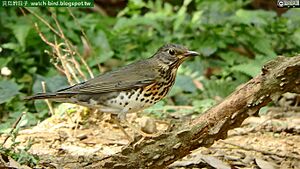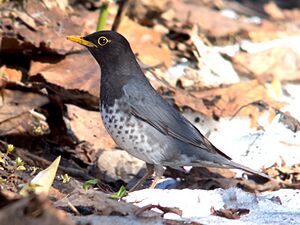Japanese thrush facts for kids
Quick facts for kids Japanese thrush |
|
|---|---|
 |
|
 |
|
| Female above, male below | |
| Conservation status | |
| Scientific classification | |
| Genus: |
Turdus
|
| Species: |
cardis
|
The Japanese thrush (Turdus cardis) is a cool bird from the thrush family, called Turdidae. People also call it the grey thrush or the Japanese grey thrush. It's a special bird because it's considered monotypic. This means that even though scientists once thought there were two different types, they now know that all Japanese thrushes are just one species. Any small differences you see are just natural variations.
Contents
Where Do Japanese Thrushes Live?
The Japanese thrush is a migratory bird. This means it travels long distances between its breeding areas and its winter homes.
Breeding and Wintering Grounds
These birds breed in central China and Japan. They usually arrive in Japan around April or May to lay their eggs and raise their young.
When the weather gets colder, around October, they leave their breeding grounds. They fly south to spend the winter in warmer places. Their winter homes include coastal southern China, the island of Hainan, northern Laos, and Vietnam.
Occasional Sightings
Sometimes, Japanese thrushes are seen in other places. They might pass through Taiwan during their migration. Very rarely, a bird might get lost and end up in a place it doesn't usually visit, like Thailand. This is called being a "vagrant."
Their Favorite Homes
Japanese thrushes usually live in forests and woodlands. They like both deciduous forests (where trees lose their leaves in autumn) and mixed forests (with both deciduous and evergreen trees). You might also find them in younger, "secondary" forests that have grown back after being cut down. Sometimes, they even visit gardens and parks!
What Do Japanese Thrushes Look Like?
The Japanese thrush is a medium-sized thrush. What's really interesting is that the male and female birds look quite different! This is called sexual dimorphism.
Male Japanese Thrush
The male Japanese thrush is very striking. It has a black head, chest, back, wings, and tail. Its belly is white, but it has black spots on the upper part of its belly and sides. The male's legs, beak, and the thin ring around its eyes are all bright yellow.
Female Japanese Thrush
The female Japanese thrush has a different look. Her upper body is brown. Her throat, chest, and belly are white. The sides of her body have a rusty orange color, and she also has black spots.
What Do They Eat and How Do They Reproduce?
Japanese thrushes are clever at finding their food. They mostly eat on the ground.
What They Eat
They scratch through fallen leaves to find tasty insects and earthworms hiding underneath. They also enjoy eating fruit.
Life Cycle and Reproduction
When it's time to build a nest, they use twigs and moss. They hold the nest together with mud and then line it with soft materials like hair and small roots.
A female Japanese thrush usually lays between 2 and 5 eggs. She sits on the eggs to keep them warm, a process called incubation, for about 12 to 13 days. Once the chicks hatch, they stay in the nest for about 14 days. This is called the nestling period.
Japanese thrushes often raise two families in one season! This is called "double brooding." The female will lay a new set of eggs soon after her first set of chicks are old enough to leave the nest.


